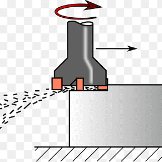-
Posts
1,284 -
Joined
-
Last visited
-
Days Won
3
huskermcdoogle last won the day on August 16 2023
huskermcdoogle had the most liked content!
Uncategorized
-
Location
North Woods of NH
Recent Profile Visitors
huskermcdoogle's Achievements
-

Does anyone use sandvik 460 drills?
huskermcdoogle replied to Leon82's topic in Machining, Tools, Cutting & Probing
IMHO, that's too much feed for Titanium to keep a straight hole and for the drill to hold up. I'd be .0015-.002 ipr and about 110sfm, for best hole quality I would use a Kennametal YPL drill, three margin, acts like a gundrill. For the cheapest thru coolant drill option I would use a Kennametal GOdrill. Marginless, won't bind up in the hole, usually very good bang for the buck. -
Sounds to me like you have a tuning issue (low likelihood) or hardware issue in the drive board to me. If your Z-axis uses the same drive board as X or Y, you could consider swapping it with another axis and see if the problem goes away. If that's the case then you have a bad drive. There may be more sophisticated testing you could do. But I am uninitiated in troubleshooting them by means of anything other than plug and chug. Do you have more than one of these model machines to compare with? If you feed it up in z slowly, stopping and starting frequently, is the load dead smooth and repeatable? Unless you have a right angle head, you can't really easily do a test that would repeat an issue I once had. But if you side mill while compound feeding that axis with another while it is loaded (Z+) , you would be able to see it clear as day in the finish.
-
11775.0 is Smooth TCP correct? It would seem to me that it isn't configured properly on the machines that don't like it...... That would be a fun one to dive into and diagnose. But also goes to show how all of those options intertwine and make it very hard to configure a "stock" configuration, that works on most setups. No two builders option machines exactly the same, no builder typically options two like machines exactly the same either.... That to me is the head scratch.
-
DING DING DING When running high feed cutters, in my experience, when climb should have worked best, conventional cutting has worked better, as well as the opposite case. It is highly dependent on toolpath style as well as material and part shape. When running in Ti, Inco, or other super alloys, I now always advise my customers to try both ways. I have seen 3-5x differences in tool life with zero difference in processing time or speeds and feeds. When you get that much more life often I have been able to really boost productivity by then balancing the tool life with speed and hitting the right tool change interval. Let's just say you get 1 part going climb, you switch to conventional and you get 5 parts. You then increase the speed 30%, and now you get 2.5 parts. So you bump it up 5% more and now you get 2.1 parts and change them at 2 so you have a little wiggle room. 35% on productivity is huge and think, you are using 50% of the inserts you were. It's a made up example, but to Ron's point. TEST TEST TEST, you won't know unless you try.
-

(Question) Selective insert changing
huskermcdoogle replied to randy5061's topic in Machining, Tools, Cutting & Probing
Another thing to note when you have some inserts that are worn and others that don't appear to be. Runout is certainly the normal cause. Fix that and the problem will be less apparent. But I find usually it is also a sign that you don't have the right cutting parameters. If you are taking enough chip load and are going fast enough to not get built up edge a few thousands of runout won't cause you any harm. But if going too slow, some inserts may be failing early due to built up edge ripping the coating off the inserts. This will appear randomly as wear on some inserts but not on others especially on easy to machine softer steels like A36. Otherwise, too little feed will rub on some and cut on others as the difference in chip load due to runout will put you on the other side of not enough feed. Feed 25% harder and it might go away. If it doesn't, check the speed. If it were me... In A36, I would be running a CVD coated insert @1200+ SFM and about .010"ipt as a starting point. Unless you have ground inserts, .0005" runout axially or radially is asking for a bit much. For standard pressed inserts in a milling cutter .0015-.002 isn't abnormal, especially in the 3-5" range. If the inserts are clocked the same way they were pressed, .001 should be achievable, but you may have to play with swapping inserts and pockets around, or custom clocking the inserts to fine adjust, especially if there is a little mileage on the cutter. For ground periphery sub .001, should be pretty easy as long as everything is clean, and the body and mounting is in good shape. If your screws are worn, replace them, so you can get consistent torque. Better yet torque your screws, and plan to replace screws on a regular basis. -
Boy that is an annoying bug. But at least someone has figured that out!
-

Wanted: Old Mastercam versions... V2, V3, V4
huskermcdoogle replied to mark casella_1838's topic in Industrial Forum
I just disposed of one last year. Bummer. Doubtful, but there still might be one at my parents place. The one I have in mind was an IBM with 8MB of RAM. Was an expensive one back in the day. -

G54.2 vs G54.4 for HMC
huskermcdoogle replied to SlaveCam's topic in Machining, Tools, Cutting & Probing
I believe G54.2 on a Mazatrol is more akin to G43.4 on a Fanuc. That is old corrupted memory..., but as I recall that's the case. -
Happy I'm not the only one I pretty much do all of my surfacing with morph or parallel strategies now. Once I got to know how to manipulate them, I just don't want to use the standard 3D toolpaths anymore. The only time I really do use the standard 3d paths now is when I need cleaner "filtered" code due to memory or control constraints, or I am helping a customer that doesn't have Multiaxis in Mastercam.
-

TRANSFORM -ROTATE+TRANSLATE
huskermcdoogle replied to Fine Machine's topic in Machining, Tools, Cutting & Probing
I have had to do this with patterning as well in the past for making parts on multiple faces. You will end up with crapload of transform operations, but it is absolutely possible to do it with sub programs, and also possible to maintain 100% associativity back to the main operations. You can have it wind up and unwind your rotary as you go tool by tool as well. Makes for a very efficient executing program with fewest tool changes and least amount of rotary movement. Lot's to keep track of, but at the end of the day it works very well. IIRC to rotate 180 degress in xy and then 90 about y, then pattern with work offsets, and sub, it took 4 or 5 transform ops to do it properly. Also, the mention of going crosseyed is also a very mild description of what happens if you walk away and try to come back and decode what you have to do to alter/finish the job. -
XYZ zero will be at COR, and offset will match same location in the machine If there is an offset between the two rotaries, you will need to put that in the post. Should be a pretty small value in this case.
-

Post Processor Installation
huskermcdoogle replied to David123's topic in Machining, Tools, Cutting & Probing
Does your IT Department manage the pc's using an image? Or if they do manage them with scripted installs, you could theoretically script the installs and then make a quick powershell script that would copy all needed files to each machine. That said, do it with JP's method and just push the config file out to each machine once it is installed. -
In my recollection, all safe index does is split the xy and rotatry motion onto two lines. The Z retract is only affected by ret_on_index. But it's been a while since I played with or modified that logic, I have made heavy modifications to this logic many times, more than I should have for sure, so I may be mistaken on that.
-

Functions from Comments
huskermcdoogle replied to metzenwest's topic in Post Processor Development Forum
Yeah I have a had this idea to control high speed settings (G05.1 ect), for a while now. Haven't done it yet, but I will eventually. For me I would use it on top of MI/MR values and make it so you can do one or the other. One of those things that you need to know it's there to use it. Hence why it likely isn't done very often. but being able to use comments to pass data, you can pass a lot of settings in a very efficient manner when it comes to turning them on and off.
Join us!
eMastercam - your online source for all things Mastercam.
Together, we are the strongest Mastercam community on the web with over 56,000 members, and our online store offers a wide selection of training materials for all applications and skill levels.











